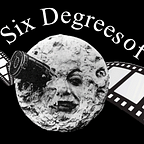The Rise of TV: Excerpts from 6 Degrees of Film
The following was from a post created with excerpts from the book “6 Degrees of Film: The Future of Film in the Global Village” that talked about the transitional period of the fifties when the Golden Age of Film was slowly dying and the era of television had begun!
At Christmas, the networks are planning to air some classic episodes of “I Love Lucy”…the extraordinary appeal of the TV series is unparalleled and began soon after the sitcom first aired. Here is an excerpt about the early Screen Gems studio…
The Rise of TV
This is one medium that I don’t believe Hollywood can give the old run around.
— Hedda Hopper
The studios learned to cope with the impending death knell as the old order passed. Formulaic movies, such as the Abbott and Costello and Ma and Pa Kettle movie series, were big draws. Science-fiction films were the order of the day in the 1950s. Some of the low-budget studios like Republic had retooled with telefilm productions by the late 1940s, and began selling their old features and shorts to television.
In 1949, Columbia created Screen Gems, a Hollywood-based telefilm company, that started actual productions for television in 1951. Desilu also came into its own in the early 1950s. The story was that Lucille Ball did not want to work in New York. She also wanted her husband, Desi Arnaz, to star with her. When they didn’t get what they wanted, Desi created Desilu to produce the pilot himself. They worked out of a Hollywood rental facility called General Services Studio.
After the pilot for I Love Lucy was shot, Arnaz and Ball convinced CBS to back the series. They signed for thirty-nine episodes, and the rest is history. Premiering in September 1951, the show was a runaway hit. CBS wanted a live audience that seated three hundred spectators. Each episode of I Love Lucy was created essentially as a stage play, and theirs became the format for the modern-day situation-comedy or sitcom. The show was filmed with three cameras running at once, and cut through three editing machines. The thirty-minute show could also be rebroadcast, creating the idea for the rerun.
Lucy drew two-thirds of the viewing audience and was the first show to reach ten million households. What’s more, Desilu Productions could create 350 half-hour episodes at a fraction of the cost at which the major Hollywood studios could crank out films. The sitcom, a wonderfully profit-driven business opportunity, firmly nailed the lid on the coffin of the outdated studio system.
1955
Three major events in 1954 cemented the inevitable fall of the studio era and its eclipse by the age of television. First, Screen Gems, a subsidiary of Columbia Pictures, premiered Father Knows Best using a former MGM star, Robert Young. Second, the legendary David O. Selznick made a comeback of sorts and made television history when he produced a two-hour TV spectacle celebrating the anniversary of Edison’s invention of the light bulb. The program was simulcast on all three major networks and drew the largest viewing audience of the era . The third event was the premiere of Walt Disney’s anthology television series.
Disney, a master marketer and promoter, realized the potential in television in marketing his films, plus promoting Disneyland, his new theme park, and advertising the Disney brand. He could recycle all the old Disney film productions like Davy Crockett on television. The show was an instant hit.
With the potential of television now being realized, the studios unloaded sizable portions of their back-lot vaults. The studios had to adapt and transform themselves into distribution companies. The studio era was over, becoming something we all like to remember and marking the end of Hollywood’s Golden Age of Film.
